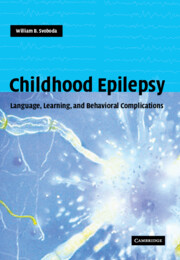Book contents
- Frontmatter
- Contents
- Preface
- Glossary
- 1 Looking ahead
- Part I Speech and language problems
- Part II Learning problems
- Part III Behavior problems
- 27 Mental health needs
- 28 Psychologic development
- 29 Seizure types and modifying factors
- 30 Overview: extrinsic factors
- 31 Behavior problems: general
- 32 Attention deficit disorders
- 33 Anxiety disorders
- 34 Mood disorders
- 35 Disruptive behavior problems
- 36 Psychoses of epilepsy
- 37 Non-epileptic events
- 38 Possible treatment issues
- 39 Helping with psychiatric problems
- 40 Epilog
- Index
- References
34 - Mood disorders
from Part III - Behavior problems
Published online by Cambridge University Press: 26 October 2009
- Frontmatter
- Contents
- Preface
- Glossary
- 1 Looking ahead
- Part I Speech and language problems
- Part II Learning problems
- Part III Behavior problems
- 27 Mental health needs
- 28 Psychologic development
- 29 Seizure types and modifying factors
- 30 Overview: extrinsic factors
- 31 Behavior problems: general
- 32 Attention deficit disorders
- 33 Anxiety disorders
- 34 Mood disorders
- 35 Disruptive behavior problems
- 36 Psychoses of epilepsy
- 37 Non-epileptic events
- 38 Possible treatment issues
- 39 Helping with psychiatric problems
- 40 Epilog
- Index
- References
Summary
Hippocrates felt that melancholiacs become epileptics and epileptics become melancholic. What is spoken of now as mood disorders of epilepsy was once envisioned as an epileptic personality described as languid, spiritless, unsociable in any period of life, sleepless, and subject to many horrid dreams (Kanner & Balabanov, 2002).
Mood disorders include major depression, bipolar disorder, dysthymic disorders, and a double depression state. Major depression usually begins in late adolescence but has been diagnosed as early as four years of age. A bipolar disorder may vary as to the age of appearance. In children and younger teens, both mania and deep depression may present simultaneously, whereas in older adolescents, the more typical cycle between mania and deep depression is noted. A dysthymic disorder is a chronic, persistent, mild depression that begins in early childhood and lasts for decades. A double depression is seen in individuals who alternate between a dysthymic disorder and a major depression.
In epilepsy, there are three types of mood disorder, ictal, peri-ictal, and interictal. Peri-ictal disorders include the cluster of affective systems that may precede or follow a seizure by hours to days. Ictal disorders represent seizures presenting with affective symptoms. There is an interictal dysphoric disorder with an intermittent course, including depressive mood, lack of energy, pain, and insomnia. The affective symptoms include irritability, euphoria, fear, and anxiety (Barry et al., 2001).
Depression
Depression is often unrecognized and undertreated in patients with epilepsy, especially children.
- Type
- Chapter
- Information
- Childhood EpilepsyLanguage, Learning and Behavioural Complications, pp. 508 - 532Publisher: Cambridge University PressPrint publication year: 2004



